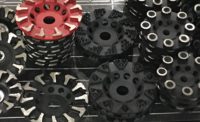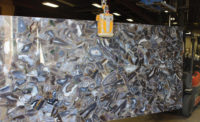
Question: I am a bit confused on the issue of rodding granite countertops. I have talked with a lot of fabricators, and they seem to be divided on the benefits of rodding. Some say it's not necessary, and some say that they rod everything. I was hoping you could shed some light on this subject.
Answer: Like any other topic, you are going to find as many opinions as there are ... well, you know. In my book, rodding is definitely worth the effort, and here is why. We have conducted numerous rodding experiments with granite using the following procedure:
During each of our fabrication seminars we take a 2-cm granite strip measuring anywhere from 50 to 60 inches long and about 2 inches wide. We have tested Black Absolute, Gaillo Venzinio, Mt Airy, Blue Pearl, Tan Brown, Dakota Mahogany and over a dozen others. We insert a rod as per the procedure I will describe later in this column. Another strip is not rodded and serves as our control. We lay the pieces across two 2 x 4's and place a metal bar approximately 3¿inch wide in the center of the granite strip. We first test the unrodded strip by placing weight on top of the metal strip. In almost all cases, the stone breaks anywhere from 20 to 30 pounds.
Next we do the same with the rodded strip. Guess what happens? Most of the time, the stone will not break, but will bend as much as 2 inches. To see this is amazing, and the very first time I did this, I did not think that stone would bend like this. In some cases, we have used over 235 pounds before the stone would even crack. Most of the time, the stone could be bent back to its normal straight position, and the crack filled with a polyester or epoxy.
The Marble Institute of America has also done a similar study, which shows that rodding does give strength to granite. I have even conducted informal surveys among granite fabricators. I have found that the fabricators who rod will rarely, if ever, break any countertops. Those who don't rod will break several a year.
I also get many questions from fabricators as to the type of rod to use. Should you use stainless or not? Should you use threaded rods? Again, based on our experiments, it is not necessary to use stainless as long as the rod is thoroughly encapsulated in epoxy. All you need is just one little spot to start rusting, and you take the chance of the stone cracking through -- a process known as "iron jacking." This is not a good thing. If you have any concerns with this, then stainless is the way to go, but it is not really necessary.
Speaking of epoxy, I have seen fabricators use polyester instead of epoxy. Some have had some success, but others have not. My recommen-dation would be to go with epoxy. Epoxies are stronger, and the stone does not have to be 100% dry. Polyesters do not do well with a stone that has any moisture, and you risk the chance of a poor bond. Many have concerns that epoxies take 12 hours or more to set up, and this is the reason they don't use epoxies. This is not true, as there are some newer generation epoxies now available that set up in a lot less time.
The type of rod I like to use is a 1¿ x 1¿inch steel flat bar. The rod should be inserted on edge (with the 1¿inch inserted as the depth or the thickness). The shape of the rod is like an "I" beam, and inserting this way will give it the most strength. Threaded rods can also be used, but I find they are not as strong as the flat bar.
The following is the technique we use to rod:
1. After cutting the stone to size, lay out the piece for additional cutouts such as sinks, cooktops, faucets, outlets, notches and other cutouts.
2. Once you have completed the layout of any cutouts, then lay out the location(s) for the rod(s). Be sure that the rod(s) will extend beyond the cutout area by at least a couple inches on each side.
3. Place the top face down on a smooth, soft, flat and clean surface on a work or saw table.
4. Select a blade that is 1¿ to 1¿ inch thicker than the 1¿inch width of the rod.
5. Mark the blade about 1¿ to 1¿inch deeper than the 1¿inch depth of the rod.
6. Cut the rod slot in the marked section on the bottom of the stone. Be sure to extend your cut far enough for the full length of rod to fit in (allowing for the curve of the blade).
7. Check the rod in the slot to verify the fit.
8. Remove the rod with a putty knife or a regular screwdriver.
9. Clean the stone and allow it to thoroughly dry.
10. Abrade the rod with a course grit abrasive, clean it, and allow it to thoroughly dry.
11. Mix a flowing consistency adhesive, and pour it into the slot of the stone.
12. Quickly insert the rod fully into the slot. Then wipe the excess adhesive over the slot to completely cover the rod.
13. Allow the adhesive to cure completely before moving the stone.




